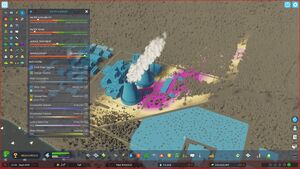There are five types of pollution in Cities: Skylines II: ground, air, water, groundwater and noise pollution.
Ground pollution
Ground pollution is visible and appears as discolored ground and has the following effects:
- If near residential zones it lowers the citizens' health
- If near trees it kills them
- If near Fertile Land natural resources it destroys the resource
- If near water it causes water pollution
Ground pollution lowers the citizens' health if near residential zones and destroys Fertile Land and Forest natural resources if underneath them.
Ground pollution is caused mainly by industry, with the exception of farming and forestry specialized industry. It is also caused by other polluting buildings, such as fossil-fuel power plants and garbage management buildings, which have an area around them they will pollute. Even if the source of the pollution is removed, it will take some time for the ground pollution to disappear. If non-polluting buildings have uncollected garbage for a long time, they will also pollute the ground. Sewage water can also cause ground pollution, especially near the outlet or treatment plant. A water flow will remove ground pollution, though only until the building resumes polluting.
Groundwater pollution
When ground pollution comes in contact with groundwater it will quickly pollute the entire deposit. If ground pollution is removed groundwater pollution will go away at the same as the deposit's replenishment rate. If polluted groundwater is pumped in the city's water network it will quickly reduce the health of all citizens.
Air pollution
Air pollution lowers the citizens' health if near residential zones. Air pollution travels with wind direction and expands and dilutes as it mixed with unpolluted air. Rain will reduce air pollution.
Air pollution it is caused mainly by traffic and industry, with the exception of farming and forestry specialized industry. It is also caused by other polluting buildings, such as fossil-fuel power plants and garbage management buildings, which have an area around them they will pollute. Even if the source of the pollution is removed, it will take some time for the air pollution to disappear. If non-polluting buildings have uncollected garbage for a long time, they will also pollute the air. Sewage water can also cause air pollution, especially near the outlet or treatment plant.
Electric cars and busses do not release air pollution, so they are a great choice if the player wants to reduce air pollution.
Water pollution
Water pollution happens when sewage is pumped into water or when ground pollution gets near water. Water pollution travels with water flow and expands and dilutes as it mixed with unpolluted water. If polluted water is pumped in the city's water network it will quickly reduce the health of all citizens so it is important to plan the placement of both the Water Pumping Station and Sewage Outlet to avoid contaminating your water supply. The player must also be wary of placing groundwater pumping stations on top of polluted groundwater deposits. Inspecting the Water infoview and its Surface Water Flow overlay gives you information about the direction and strength of the water flow on the map.
Noise pollution
Noise lowers the citizens' well-being if near residential zones. Noise pollution is caused by traffic, industry and commercial zones. It is also caused by various buildings, which have an area around them they will pollute.
On roads, a general rule is "the heavier the traffic, the heavier the noise". Each type of vehicle has a noise pollution rating, so the amount of traffic noise is dependent not only on how much traffic is present on the road, but also on what types of vehicles are present. Large trucks will typically create more noise.
Roads with trees and highways with sound barriers will help to reduce noise produced by vehicles. Noise generated by vehicles on roads under the ground will also be completely suppressed. However, elevated roads will increase noise pollution.
Trees will reduce noise pollution, but must be used in large numbers to see a significant effect.

